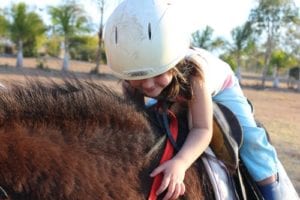Written by Joyce Smith, BS. Ten weeks of a therapeutic horse riding group intervention significantly increased social interaction skills with horses which crossed over to positive changes in participants’ interactions with their family pets.
 Research has shown that a strong association exists between children and their pets, whereby pets provide children with comfort and a feeling of security that can translate to positive social and stress management 1. However, children with autistic spectrum disorder (ASD) have impaired communication and social skills, restricted interests, and an insistence on identical and repetitive behaviors which often affect their social interactions with family members, including family pets 2. They also have difficulty in social environments and don’t understand how their behaviors affect others 3. Interventions that teach and translate into appropriate care of animals are urgently needed 4.
Research has shown that a strong association exists between children and their pets, whereby pets provide children with comfort and a feeling of security that can translate to positive social and stress management 1. However, children with autistic spectrum disorder (ASD) have impaired communication and social skills, restricted interests, and an insistence on identical and repetitive behaviors which often affect their social interactions with family members, including family pets 2. They also have difficulty in social environments and don’t understand how their behaviors affect others 3. Interventions that teach and translate into appropriate care of animals are urgently needed 4.
Based on previous studies, 3,5 Petty et al hypothesized that children and adolescents with ASD, who participated in a 10-week therapeutic horseback riding (THR) intervention, would learn appropriate social interaction skills with horses and that these skills would generalize to an increase in positive interactions with their family pets. A control group of ASD children would participate in a 10-week similar intervention that would allow no interaction with horses.
Of the sixty-seven ASD participants 6, aged 6-16, thirty-one participated in a 10-week THR program consisting of lessons and riding time while the remaining thirty-six participants took part in barn activities but had no interaction with horses. Instead, they focused on learning about horse care, safety rules around horses and how to groom them. Each child was assigned a caregiver who completed questionnaires concerning the child’s interactions with household pets before and after both training programs.
Caregivers of the THR group reported a significant increase in the number of positive interactions with their household pets compared to participants in the “barn activity only” group as ascertained by animal attachment scores (AATS) and animal abuse scores (AABS). The AATS scores of participants in the THR group significantly improved from 13.59 to 15.4 after intervention (p = 0.003) while the scores of BA participants showed no trend of improvement (p = 0.69).
This is the first known study that examines the crossover effects of therapeutic riding in ASD children with respect to their attitudes and caring behavior toward family pets. In this study the majority of the household pets were dogs. The authors hope that “Engaging with horses during a standard therapeutic riding intervention protocol may generalize to improving caring action toward family pets in children and adolescents with ASD.” These results align with previous research demonstrating how pet dogs improved family functioning and reduced anxiety in children with ASD 7. They suggest that future studies measuring the impact of human-animal interaction on caregivers and family functioning may be useful.
Source: Petty, Jessie, Shaoxing Pan, Briar Decant, and Robin Gabriel’s. “Therapeutic horseback riding crossover effects of attachment behaviors with family pets in a sample of children with autism spectrum disorder.” International journal of environmental research and public health 14, no. 3 (2017): 256.
© 2017 by the authors. Licensee MDPI, Basel, Switzerland. This article is an open access Article distributed under the terms and conditions of the Creative Commons Attribution (CC BY) license (http://creativecommons.org/licenses/by/4.0/
Click here to read the full text study.
Posted June 10, 2019.
Joyce Smith, BS, is a degreed laboratory technologist. She received her bachelor of arts with a major in Chemistry and a minor in Biology from the University of Saskatchewan and her internship through the University of Saskatchewan College of Medicine and the Royal University Hospital in Saskatoon, Saskatchewan. She currently resides in Bloomingdale, IL.
References:
- Walsh F. Human-animal bonds II: the role of pets in family systems and family therapy. Family process. 2009;48(4):481-499.
- Association AP. Diagnostic and Statistical Manual of Mental Disorders. 2013; https://www.psychiatry.org/psychiatrists/practice/dsm.
- O’Haire ME. Animal-assisted intervention for autism spectrum disorder: a systematic literature review. J Autism Dev Disord. 2013;43(7):1606-1622.
- Radley KC, O’Handley RD, Ness EJ, et al. Promoting social skill use and generalization in children with autism spectrum disorder. Research in Autism Spectrum Disorders. 2014;8(6):669-680.
- Carnahan CR, Hume K, Clarke L, Borders C. Using structured work systems to promote independence and engagement for students with autism spectrum disorders. Teaching Exceptional Children. 2009;41(4):6-14.
- Petty JD, Pan Z, Dechant B, Gabriels RL. Therapeutic Horseback Riding Crossover Effects of Attachment Behaviors with Family Pets in a Sample of Children with Autism Spectrum Disorder. Int J Environ Res Public Health. 2017;14(3).
- Wright H, Hall S, Hames A, et al. Pet dogs improve family functioning and reduce anxiety in children with autism spectrum disorder. Anthrozoös. 2015;28(4):611-624.
